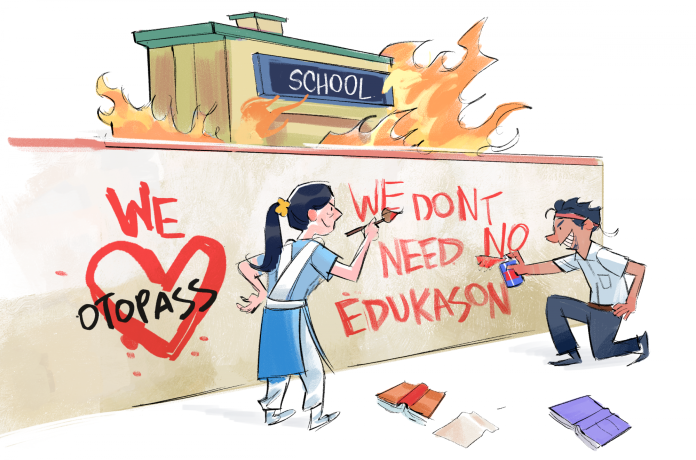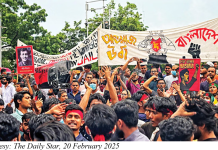The surprising lack of an education reform commission within Bangladesh’s interim government is no administrative error but an indicator of systemic disregard for a sector hanging off the edge of a cliff. Figures tell an alarming story: at 98.3% primary level of coverage (Bangladesh Bureau of Educational Information and Statistics, 2023), 35% of students drop out at secondary level, 47% of graduates are unemployed (World Bank, 2023). In parallel, only 14% of youth have vocational training while 82% of employers recognize shortages of skills as an employment hindrance (ILO, 2022). These data indicate a paradox—Bangladesh’s education system produces quantity, not quality, with devastating consequences for demographic dividend and economic aspiration.
The roots of this crisis are in decades of policy inertia. The National Education Policy (NEP) 2010, which had visualized lesser rote learning and more use of technology, is still 60% unimplemented because of underfunding and bureaucratic red tape (Education Ministry Internal Report, 2022). For instance, only 18% of secondary schools have functional science labs and only 12% of teachers have been trained in digital pedagogy (CAMPE, 2023). The curriculum, which has not been revised since 1985, continues to allocate 70% of class time to memorization-based assessment, whereas international counterparts such as Vietnam and Sri Lanka have allocated 50-60% of their curricula to problem-solving and critical thinking (UNESCO, 2021). This disparity is quite evident in the tertiary outcomes as 33% of Bangladeshi public university graduates need remedial training to be employable compared to 10% in India and 8% in Malaysia. (World Economic Forum, 2023).
Systemic and geographical inequalities deepen these weaknesses. Rural schools, which enroll 65% of students, have 1 teacher for every 52 students, while cities have 1 for every 36 (BANBEIS, 2023). Madrasahs, where 11% of the students are enrolled, allocate 40% of their curriculum to religious studies, leaving their alumni with limited possibilities in the formal economy (PRI, 2022). The digital gap is equally pronounced: during the time of COVID-19, 45% of children did not have internet access, and 73% of rural families were unable to afford smartphones for distance learning (UNICEF, 2021). An estimated $1.2 billion government campaign to digitize learning paid off for just 22% of schools with promised devices by 2023, with 30% experiencing hardware failures within six months (A2I, 2023).
Corruption further weakens the system. In a 2022 Transparency International survey, 41% of parents bribed their way into school admissions, and 28% of teacher appointments were due to political patronage. Textbook distribution, a $150 million annual activity, has been plagued by delays and “ghost schools”—10–15% of books distributed vanish every year, per the Anti-Corruption Commission. Such leaks divert funds from urgent necessities: 34% of primary schools lack clean water, and 27% lack electricity (DPE, 2023).
Earlier reforms have been diluted on political agenda grounds. The 2018 Higher Education Commission Act to give autonomy to universities was undermined by amendments in which political appointees dominated governing boards. As a result, 60% of the vice-chancellors at public universities since 2020 have had clear political affiliations, compared to 25% before 2018 (DU Teachers’ Association, 2023). Similarly, the much-publicized stipend program for female students that raised enrolment at secondary school level by 12% did not address reasons for dropouts : 32% of girls drop out due to marriage, and 24% cite a lack of proper sanitation (UNFPA, 2022).
The interim government’s reluctance to constitute an education reform commission is reflective of a tactical avoidance of politically explosive structural reforms. Reforming education means confronting powerful interest groups—madrasa boards, partisan teacher unions, and textbook syndicates—with significant electoral influence. The Bangladesh Madrasah Education Board, for instance, which oversees 9,500 institutions, has historically resisted secular curriculum reforms for fear of losing its hold. Similarly, the recruitment of teachers, a key patronage tool of ruling parties, remains a minefield as 52% of secondary teachers in 2023 were selected by politically aligned committees rather than merit (Education Watch, 2023). Interim governments, fearful of a backlash, prefer more piecemeal measures like stipends or infrastructure projects, avoiding systematic disruption.
Bureaucratic collapse also disables advancement. With education fragmented into four ministries, coordination is zero. The Technical Education Board, for example, lacks coordination with the Secondary and Higher Education Division, resulting in replicated efforts and competing policies. A 2023 Planning Commission audit uncovered that 27% of education projects overlap between ministries, squandering $120 million annually. A cross-ministerial reform commission could unify these silos but would face resistance from bureaucrats protecting their domain.
With 1.8 million youth entering the labor market annually and automation threatening 58% of low-skilled jobs by 2030 (ADB, 2023), Bangladesh’s window of opportunity is closing and therefore the need for an education reform commission is more pressing than ever.
A 2023 CPD report warns that doing nothing could decrease GDP growth by 1.2% annually, and today’s youth unemployment rate of 11.9% could jump to 14% by 2030 (ILO). Contrast this with Vietnam, where one national education authority resulted in a decrease of graduate unemployment rate to 4.5% and technology exports rising to $48 billion. For Bangladesh, the commission is the missing link between population potential and economic fact. Without it, the aspirations of 28% of its under-14 population—and the nation’s $700 billion GDP target—will remain unfulfilled. The figures leave no room for doubt: reform is not a choice, but a reckoning.
Data Sources & References
- Primary Enrollment Rate (98.3%):
- Bangladesh Bureau of Educational Information and Statistics (BANBEIS), 2023 Annual Report.
- Link: BANBEIS Publications
- Graduate Unemployment (47%):
- World Bank, Bangladesh Education Sector Review, 2023.
- Link: World Bank Bangladesh Education
- Vocational Training (14%) & Employer Skill Gaps (82%):
- International Labour Organization (ILO), Skills Mismatch in Bangladesh, 2022.
- Link: ILO Bangladesh Reports
- Unimplemented NEP 2010 (60%):
- Education Ministry Internal Report, 2022 (Summarized by The Daily Star).
- Link: The Daily Star Article on NEP 2010
- Science Labs (18%) & Digital Pedagogy (12%):
- Campaign for Popular Education (CAMPE), Education Watch Report, 2023.
- Link: CAMPE Publications
- Curriculum Time on Rote Learning (70%):
- UNESCO Global Education Monitoring Report, 2021.
- Link: UNESCO GEM Report
- Remedial Training for Graduates (33%):
- World Economic Forum, Future of Jobs Report, 2023.
- Link: WEF Future of Jobs
- Teacher-Student Ratios (Rural vs. Urban):
- BANBEIS Annual Report, 2023.
- Link: BANBEIS Data Portal
- Madrasah Curriculum (40% Religious Studies):
- Policy Research Institute (PRI), Madrasah Reform Study, 2022.
- Link: PRI Bangladesh Publications
- Digital Divide During COVID-19:
- UNICEF Bangladesh, COVID-19 Impact on Education, 2021.
- Link: UNICEF Bangladesh Education
- Device Distribution Failures (22% Received):
- Aspire to Innovate (a2i), Digital Education Progress Report, 2023.
- Link: a2i Digital Bangladesh
- Corruption in Admissions (41%) & Teacher Appointments (28%):
- Transparency International Bangladesh, National Household Survey, 2022.
- Link: TIB Corruption Reports
- Textbook Leakage (10–15%):
- Anti-Corruption Commission (ACC), Annual Report, 2023.
- Link: ACC Bangladesh
- Infrastructure Gaps (Water & Electricity):
- Directorate of Primary Education (DPE), Annual Sector Performance Report, 2023.
- Link: DPE Bangladesh
- Politicization of Universities (60% VC Appointments):
- Dhaka University Teachers’ Association Report, 2023 (Covered by Prothom Alo).
- Link: Prothom Alo Article
- Dropout Drivers (Child Marriage, Sanitation):
- UNFPA Bangladesh, Gender and Education Study, 2022.
- Link: UNFPA Bangladesh Reports
- Economic Cost of Skill Gaps (1.2% GDP Loss):
- CPD, Bangladesh Economic Outlook, 2023.
- Link: CPD Publications
- Automation Risk (58% Jobs):
- Asian Development Bank (ADB), Future of Work in Asia, 2023.
- Link: ADB Reports
- Vietnam’s Education Success:
- World Bank, Vietnam Education and Jobs, 2023.
- Link: World Bank Vietnam

K.M. Arshad
Undergraduate Student of The Department of Economics, University of Dhaka



